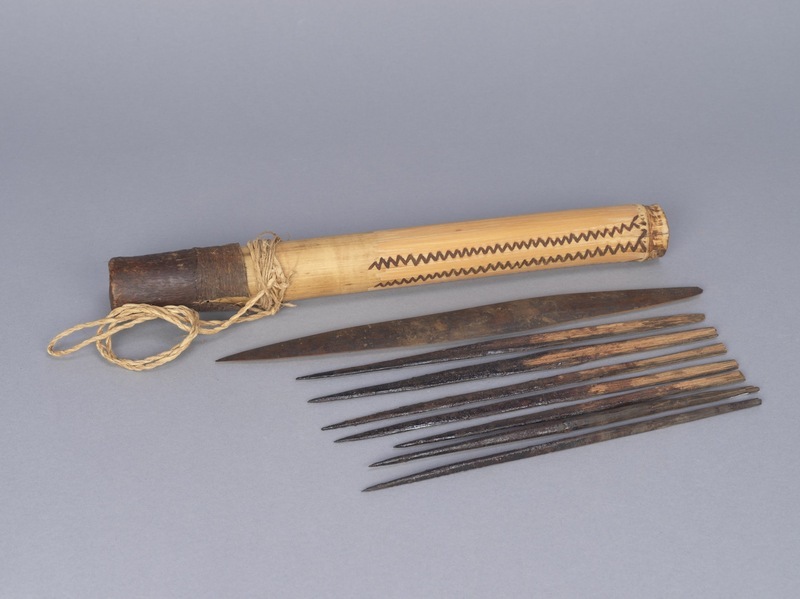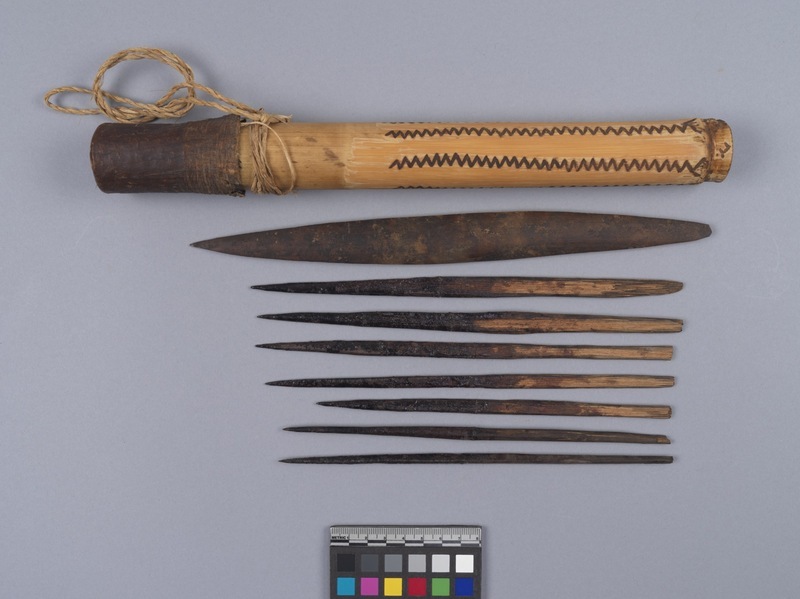Dart Container Item Number: 3301/15 a-j from the MOA: University of British Columbia


Description
Container with lid (part b), and darts/tools inside (parts c-j). Container is a hollow cylinder of wood with one closed end. Plaited plant fibre is looped around the container and tied, making a small carrying strap. The sides have been shaved lengthwise, and zigzag designs have been burned in. The lid is made from animal skin, with the hair on the interior. The tools are all made of wood. The largest tool (c) tapers in to a point at either end, and is quite flat. Smaller tools (d-j) are all composed of wood, and have a dark brown shiny substance on their pointed ends.
Narrative
The donor was a Canadian diplomat in Brazil, in the 1980s. During this time he visited the Amazonian area of Brazil where the Yanomami live.
Cultural Context
The Yanomami are a hunter-agriculturist people who live in a northern Amazon area located on both sides of the border between Brazil and Venezuela, in the Orinoco-Amazon interfluvial region. The Yanomami had little contact with people other than neighbouring indigenous groups until the 20th century. Since the 1970s they have faced significant changes. On the Brazilian side of their territory, the Terra Indígena Yanomami was established in 1992 in the face of near-genocide. To this day, almost 60 percent of Yanomami territory is covered by mineral applications and title deeds registered in the National Department of Mineral Production in Brazil by public and private mining companies, both national and multinational. Colonization projects, implemented in the 1970s and ’80s in the east and southeast of Yanomami lands, also created a wave of land occupations that are still expanding. In addition, three military bases have been installed in Yanomami territory since 1985, leading to serious social problems among the local populations. Recently, the Yanomami created the Hutukara Yanomami Association to advocate for their rights in managing their territory and responding to the various threats to their land, in partnership with several other organizations and the states of Venezuela and Brazil.
Item History
- Made in Brazil
- Owned by Michael Small before June 2, 2018
- Received from Michael Small (Donor) on June 2, 2018
What
- Name
- Dart Container
- Identification Number
- 3301/15 a-j
- Type of Item
- container
- Material
- wood, plant fibre, oil ? and skin
- Part A
- height 27.2 cm, diameter 3.5 cm
Who
- Culture
- Yanomami
- Previous Owner
- Michael Small
- Received from
- Michael Small (Donor)
Where
- Holding Institution
- MOA: University of British Columbia
- Made in
- Brazil
When
- Ownership Date
- before June 2, 2018
- Acquisition Date
- on June 2, 2018
Other
- Condition
- fair
- Accession Number
- 3301/0015 a-j